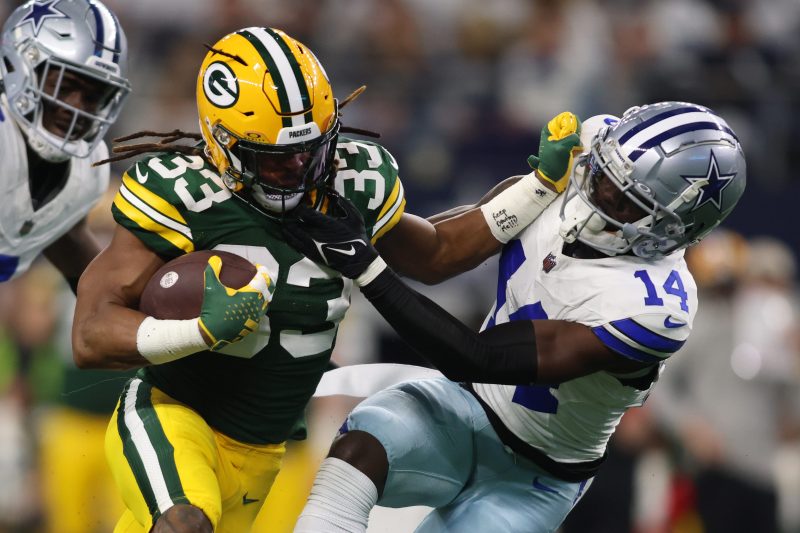New year, same sticky business when it comes to NFL running backs.
They are still prone to get the short end of the league’s gold-plated money stick.
Look at Aaron Jones. After making his mark as one of the best running backs in franchise history for the Green Bay Packers, he’s ticketed to be a Minnesota Viking now.
Yeah, those Vikings. The ones the Cheeseheads would call a dreaded division rival. At least Jones, who moves with a one-year, $7 million deal that becomes official when the NFL’s free agency market officially opens on Wednesday at 4 p.m. ET, will have a chance to extract revenge at least twice a year in the NFC North.
Never mind the praise for Jones as a first-class locker room guy or his nose for the end zone.
NFL STATS CENTRAL: The latest NFL scores, schedules, odds, stats and more.
He’s 29, with the mileage of 1,177 career carries and 272 receptions. And, well, he apparently wouldn’t take a big enough pay cut to stay in Green Bay.
Instead, the Packers brought in his replacement, Josh Jacobs, on a four-year, $48 million contract that averages $12 million – which is what Jones averaged on his last contract.
Jacobs, by the way, is three years younger than Jones.
Frozen tundra or not, it’s a cold business.
Jacobs, remember, was franchise-tagged by the Las Vegas Raiders last year ($10.091 million) after winning the NFL’s rushing crown in 2022. So, he’s landed the desired long-term deal. But did it really have to go down like that?
Saquon Barkley can ask something similar. Like Jones, Barkley has made an intra-division move to the Philadelphia Eagles after playing on the franchise tag last season. His new deal (three years, $37.75 million, per multiple reports) guarantees $26 million and averages $12.583 million.
And he gets the bonus of leaving the New York Giants for a team that, even with Jason Kelce’s retirement, provides a much more formidable wall of blockers.
Still, Barkley might have earned more if he had settled up with the Giants last year … while the Giants might have kept him if they had come with a bigger offer.
In any event, Barkley has grabbed a seat in what has resembled a game of musical chairs in what has been a rather bustling market, to some degree, for running backs.
D’Andre Swift, 25, got a nice bump from his rookie contract, which averaged about $2.135 million. In moving from the Eagles to the Chicago Bears on a three-year, $24 million deal, he’s averaging $8 million.
Right place. Right time. Right age.
‘In a general sense, I think it’s good that running backs are getting paid again,’ agent Peter Schaffer told USA TODAY Sports. ‘That’s a good thing.’
Schaffer represents running back Joe Mixon, which means he’s caught the drift on how the winds have been blowing.
When the NFL’s ‘legal tampering’ period opened on Monday, reports circulated that the Cincinnati Bengals would cut Mixon, who’s pushing 28.
By Tuesday, the plot twist emerged. The Bengals will trade Mixon to the Houston Texans.
Schaffer suspected that Mixon might hit the market; the Bengals subsequently struck a deal at $4 million per year for former Indianapolis Colts running back Zack Moss.
‘In the NFL, you always have to prepare for anything,’ Schaffer said.
Still, Mixon took a pay cut last year to stay with the Bengals. Now, rather than hitting the open market for a chance at going to the highest bidder, that option was nullified. At least he’s going to the Texans now. After years of stumbling, they stunned the NFL universe and won the AFC South title, later advancing to the AFC divisional playoffs behind rookie quarterback C.J. Stroud.
No, even though the musical chairs have filled up fast and the NFL’s salary cap is at a record $255.4 million, the running backs are not getting crazy money, relatively speaking.
The market was hardly reset. Christian McCaffrey’s $16 million average pay from the San Francisco 49ers still is the top mark at the position. And just like last year, only six running backs are slated to average more than the franchise tag number (increased to $11.951 million, lower than any tag except for kickers and punters), while several decidedly average wide receivers top that amount.
Derrick Henry? The Baltimore Ravens might have scored another coup in luring the bruising running back but didn’t have to break the bank. Henry, who averaged $12.5 million on his last contract with the Tennessee Titans, moves with an $8 million-per-year deal.
Meanwhile, Henry’s former team reached a deal with the younger Tony Pollard for that same average…which is a pay cut as Pollard played under the franchise tag ($10.091 million) last year for the Dallas Cowboys.
And for all of the negotiating twists that touchdown machine Austin Ekeler experienced with the Los Angeles Chargers in 2023 while averaging $6.125 million, he’s settled with the Washington Commanders on a two-year, $11.43 million contract averaging nearly $2 million less than his previous pact.
Ekeler is approaching 29, which apparently is not the best negotiating chip for a running back.
Sure, running backs are valuable. The movement as the market opens reflects the need. And teams will beg for that value during their playoff drives in January.
Yet putting a high price tag on that value remains a tough bargain for NFL running backs.

